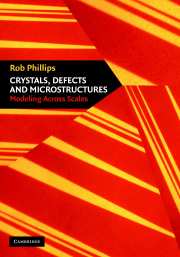Book contents
- Frontmatter
- Contents
- Preface
- Acknowledgements
- Notes on Units, Scales and Conventions
- Part One Thinking About the Material World
- 1 Idealizing Material Response
- 2 Continuum Mechanics Revisited
- 3 Quantum and Statistical Mechanics Revisited
- Part two Energetics of Crystalline Solids
- Part three Geometric Structures in Solids: Defects and Microstructures
- Part four Facing the Multiscale Challenge of Real Material Behavior
- References
- Index
2 - Continuum Mechanics Revisited
Published online by Cambridge University Press: 29 October 2009
- Frontmatter
- Contents
- Preface
- Acknowledgements
- Notes on Units, Scales and Conventions
- Part One Thinking About the Material World
- 1 Idealizing Material Response
- 2 Continuum Mechanics Revisited
- 3 Quantum and Statistical Mechanics Revisited
- Part two Energetics of Crystalline Solids
- Part three Geometric Structures in Solids: Defects and Microstructures
- Part four Facing the Multiscale Challenge of Real Material Behavior
- References
- Index
Summary
Continuum Mechanics as an Effective Theory
Materials exhibit structural features at a number of different scales, all of which can alter their macroscopic response to external stimuli such as mechanical loads or the application of electromagnetic fields. One of the fundamental difficulties faced in the modeling of materials is how to extract those features of the problem that are really necessary, while at the same time attaining some tolerable level of simplification. Traditionally, one of the favored routes for effecting the reduction of problems to manageable proportions has been the use of continuum theories. Such theories smear out features at ‘small’ scales such as the discrete phenomena that are tied to the existence of atoms and replace the kinematic description of materials in terms of atomic positions with field variables. Adoption of these strategies leads to theories that can describe material behavior ranging from deformation of polycrystals to mass transport to the behavior of domain walls in magnetic materials.
The continuum mechanics of solids and fluids serves as the prototypical example of the strategy of turning a blind eye to some subset of the full set of microscopic degrees of freedom. From a continuum perspective, the deformation of the material is captured kinematically through the existence of displacement or velocity fields, while the forces exerted on one part of the continuum by the rest are described via a stress tensor field. For many problems of interest to the mechanical behavior of materials, it suffices to build a description purely in terms of deformation fields and their attendant forces. A review of the key elements of such theories is the subject of this chapter.
- Type
- Chapter
- Information
- Crystals, Defects and MicrostructuresModeling Across Scales, pp. 29 - 80Publisher: Cambridge University PressPrint publication year: 2001



